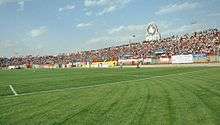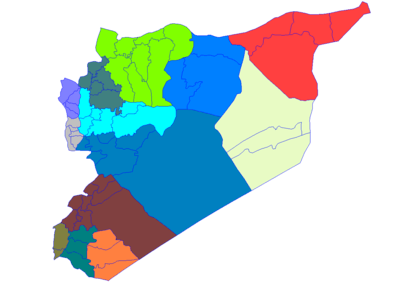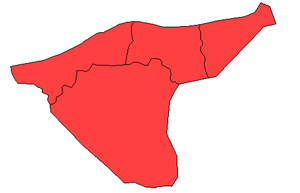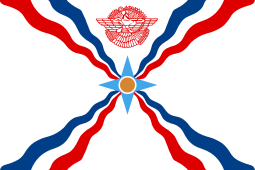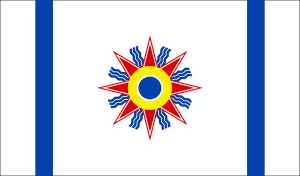Al-Hasakah
Al-Hasakah (Arabic: الحسكة,[1] Kurdish: Heseke, حەسیچە,[2][3][4] Syriac: ܚܣܝܟܐ,[5]) also known as Al-Hasakeh, Al-Hasaka or simply Hasakah, is the capital city of the Al-Hasakah Governorate, in the far northeastern corner of Syria.[6] With a population of 188,160 residents in 2004, Al-Hasakah is among the ten largest cities in Syria and the largest in the governorate. It is the administrative center of a nahiyah ("subdistrict") consisting of 108 localities with a combined population of 251,570 in 2004.[7]
al-Hasakah الحسكة Heseke | |
|---|---|
City | |
 Al-Hasakah and the Syriac Orthodox Church of the city | |
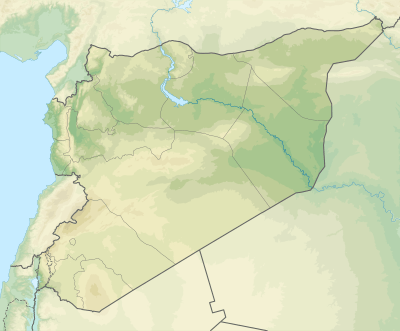 al-Hasakah Location in Syria | |
| Coordinates: 36°30′42″N 40°44′32″E | |
| Country | |
| Governorate | al-Hasakah |
| District | al-Hasakah |
| Subdistrict | al-Hasakah |
| Control | |
| Elevation | 300 m (1,000 ft) |
| Population | |
| • Estimate (2004) | 188,160 |
| • Metro | 251,570 |
| Demonym(s) | Arabic: حسكاوي, romanized: Ḥaskāwi |
| Area code(s) | 52 |
| Geocode | C4360 |
In 1992, Al-Hasakah was described as "an Arab city with a growing Kurdish population".[8] Other minorities such as Assyrians and a smaller number of Armenians also live in the area.[9][10]
Al-Hasakah is 80 kilometres (50 miles) south of the city of Qamishli. The Khabur River, a tributary of the Euphrates River, flows through the city. The Jaghjagh River flows into the Khabur River at Al-Hasakah. Around 25% of the city is a Syrian government-controlled enclave, with the rest of the city (and the surrounding countryside) controlled by the Autonomous Administration of North and East Syria.
History
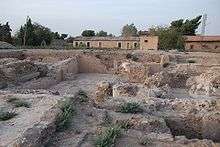
In the city centre, an ancient tell has been identified by Dominique Charpin as the location of the city of Qirdahat.[11] Another possibility is that it was the site of the ancient Aramean city of Magarisu, mentioned by the Assyrian king Ashur-bel-kala who fought the Arameans near the city.[12] The etymology of Magarisu is Aramaic (from the root mgrys) and means "pasture land".[13] The city was the capital of the Aramean state of Bit-Yahiri invaded by Assyrian kings Tukulti-Ninurta II and Ashurnasirpal II.[14]
Excavations in the tell discovered materials dating to the Middle-Assyrian, Byzantine and Islamic eras. The last level of occupation ended in the fifteenth century.[1] A period of 1,500 years separated between the Middle-Assyrian and Byzantine levels.[15]
There are numerous other archaeological tells in the surrounding area such as Tall Sulaymānī, 7.6 kilometers to the north of the city.
In Ottoman times the town was insignificant. Today's settlement was established in April 1922 by a French military post. After the expulsion and genocide of the Armenians in the Ottoman Empire, many refugees fled to the area and began to develop it in the 1920s.
During the French mandate period, Assyrians, fleeing ethnic cleansing in Iraq during the Simele massacre, established numerous villages along the Khabur River during the 1930s.[16] French troops were stationed on Citadel Hill at that time. In 1942 there were 7,835 inhabitants in al-Hasakah, several schools, two churches and a gas station. The new city grew from the 1950s to become the administrative center of the region. The economic boom in the cities of Qamishli and al-Hasakah was a result of the irrigation projects started in the 1960s which transformed Northeast Syria into a cotton-growing area.
Syrian Civil War
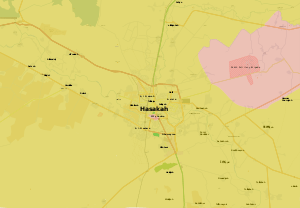
On 26 January 2011, in one of the first events of the 2011 Syrian protests,[17] Hasan Ali Akleh from Al-Hasakah poured gasoline on himself and set himself on fire, in the same way Tunisian Mohamed Bouazizi had in Tunis on 17 December 2010. According to eyewitnesses, the action was "a protest against the Syrian government".[18][19] In 2012, Al-Hasakah, which has a large Kurdish population, began witnessing protests of several thousand people against the Syrian government. From 2013, the militia associated with the Kurdish Democratic Union Party (PYD), the People's Protection Units (YPG), controlled the Kurdish districts, while the government retained control of the Arab districts. There were also clashes in the city between an Arab insurgent group and the YPG.
In the Battle of Hasakah during summer 2015, the Syrian Government lost control of much of the city to the Islamic State of Iraq and the Levant (ISIL) which were then captured by the YPG. Afterwards, some 75% of Hasakah and all of the surrounding countryside were under the administration of the Federation of Northern Syria – Rojava, while only some inner city areas were controlled by the Syrian government.[20][21][22] On 1 August 2016 the Syrian Democratic Council opened a public office in Al-Hasakah.[23]
On 16 August 2016, the Battle of al-Hasakah (2016) started, with the YPG and Asayish capturing most of the remaining areas held by government forces.[24] On 23 August 2016, an agreement between the YPG and the Syrian Army resulted in a ceasefire within the city.[25] Al-Hasakah has since been part of the Jazira Region in the framework of the de facto autonomous Federation of Northern Syria – Rojava.[26][27]
Hasakah Security Box
The Hasakah Security Box is a Syrian government enclave within al-Hasakah, established in August 2016.[28] It contains the prison, immigration office, mayor's palace, police headquarters, and local army command center.[28][29][30]
Following the second battle for the city in 2015, the Syrian government controlled 25% of the city while Rojava controlled 75%. On August 16, 2016, a small skirmish erupted into the third Battle of al-Hasakah between Asayish alongside YPG and the Syrian government for al-Hasakah. After a week-long battle, Kurdish fighters secured control over 95% of the city.[31]
Russia mediated a ceasefire that was put into place on August 23, 2016.[32] Only civilian police officers and interior ministry forces were allowed to return to the Security Box to protect the government's department buildings. In July 2018, the Syrian Army raised the Syrian flag over the Al-Nashwa District that previously was controlled by the YPG and the Asayish security forces in the city of Hasakah.[33] However, in September through November 2019, Asayish forces were still present in al-Nashwa district and able to make arrests.[34][35]
Climate
Al-Hasakah has a Mediterranean-influenced semi-arid climate (BSh) with very hot dry summers and cool wet winters with occasional frosty nights.
| Climate data for Al-Hasakah (1961–1990) | |||||||||||||
|---|---|---|---|---|---|---|---|---|---|---|---|---|---|
| Month | Jan | Feb | Mar | Apr | May | Jun | Jul | Aug | Sep | Oct | Nov | Dec | Year |
| Average high °C (°F) | 10.7 (51.3) |
13.4 (56.1) |
17.9 (64.2) |
23.6 (74.5) |
30.6 (87.1) |
36.6 (97.9) |
40.2 (104.4) |
39.5 (103.1) |
35.5 (95.9) |
28.2 (82.8) |
19.6 (67.3) |
12.5 (54.5) |
25.7 (78.3) |
| Daily mean °C (°F) | 5.2 (41.4) |
7.4 (45.3) |
11.3 (52.3) |
16.4 (61.5) |
22.6 (72.7) |
28.3 (82.9) |
31.5 (88.7) |
30.4 (86.7) |
25.8 (78.4) |
19.1 (66.4) |
11.7 (53.1) |
6.7 (44.1) |
18.0 (64.4) |
| Average low °C (°F) | 0.6 (33.1) |
2.4 (36.3) |
4.9 (40.8) |
9.3 (48.7) |
14.1 (57.4) |
19.1 (66.4) |
22.4 (72.3) |
21.5 (70.7) |
16.4 (61.5) |
10.8 (51.4) |
5.2 (41.4) |
2.2 (36.0) |
10.9 (51.6) |
| Average precipitation mm (inches) | 51.5 (2.03) |
41.3 (1.63) |
44.1 (1.74) |
49.0 (1.93) |
18.2 (0.72) |
0.5 (0.02) |
0.2 (0.01) |
0.0 (0.0) |
2.1 (0.08) |
16.5 (0.65) |
23.3 (0.92) |
42.2 (1.66) |
288.9 (11.37) |
| Average precipitation days (≥ 1.0 mm) | 7.0 | 6.4 | 6.6 | 6.2 | 2.7 | 0.2 | 0.1 | 0.0 | 0.1 | 2.5 | 3.8 | 6.2 | 41.8 |
| Mean monthly sunshine hours | 142.6 | 159.6 | 210.8 | 234.0 | 303.8 | 357.0 | 393.7 | 356.5 | 297.0 | 248.0 | 192.0 | 142.6 | 3,037.6 |
| Mean daily sunshine hours | 4.6 | 5.7 | 6.8 | 7.8 | 9.8 | 11.9 | 12.7 | 11.5 | 9.9 | 8.0 | 6.4 | 4.6 | 8.7 |
| Source: NOAA[36] | |||||||||||||
Population
Demographics
| Year | Pop. | ±% |
|---|---|---|
| 1942 | 7,835 | — |
| 1981 | 73,426 | +837.2% |
| 1994 | 119,798 | +63.2% |
| 2004 | 188,160 | +57.1% |
In 1939, French mandate authorities reported the following population numbers for different ethnic/religious groups in al-Hasakah city centre.[37]
| Arabs | Kurds | Christians | Armenians |
|---|---|---|---|
| 7133 | 360 | 5700 | 500 |
In 2004 the city's population was 188,160. Al-Hasakah has an ethnically diverse population of Kurds, Arabs and Assyrians and a smaller number of Armenians.[9][10]
The United Nations estimates that violence related to the Syrian Civil War has displaced up to 120,000 people.[38]
Religion
There are more than forty mosques in the city, as well as at least nine church buildings, serving a large number of Christians of various rites. The cathedral of the Assumption of Mary is the episcopal see of the non-metropolitan Syriac Catholic Archeparchy of Al Hasakah-Nisibis, which depends directly on the Syriac Catholic Patriarch of Antioch.
Districts
The city of Al-Hasakah is divided into 5 districts, which are Al-Madinah, Al-Aziziyah, Ghuwayran, Al-Nasra and Al-Nashwa. These districts, in turn, are divided into 29 neighborhoods.[39]
| English Name | Arabic Name | Population | Neighborhoods (Population) |
|---|---|---|---|
| Al-Madinah | المدينة | 30,436 | Al-Matar al-Shamali (9,396), Center / Al-Wista (6,067), Municipal Stadium / Al-Malaab al-Baladi (5,802), Al-Matar al-Janoubi (4,714), Al-Askari (4,457) |
| Al-Aziziyah | العزيزية | 56,123 | Al-Salehiyah (21,319), Al-Ghazal (11,199), National Hospital / Al-Mashfa al-Watani (11,108), Al-Talaia (4,883), Abou Amshah (4,435), Al-Mufti (3,179) |
| Ghuwayran | غويران | 34,191 | Sports City / Al-Madinah al-Riyadiyah (8,418), Al-Thawra (8,180), Al-Taqaddum (7,623), 16 Tishreen (5,595), Al-Zuhour (3,367), Abou Bakr (1,008) |
| Al-Nasra | الناصرة | 42,070 | Tell Hajjar (10,343), Al-Kallasah (9,721), Al-Meshirfah (8,074), Al-Qusour (7,672), Al-Beitra (2,423), Al-Mashtal (2,306), Al-Maaishiyah (1,531) |
| Al-Nashwa | النشوة | 25,340 | Al-Rasafah (12,618), Al-Masaken (4,968), Al-Khabour (3,805), Al-Liliyah (2,977), Villas / Al-Villat (972) |
Sports
Al-Jazeera SC Hasakah is the largest football club in the city and plays at Bassel al-Assad Stadium.
Gallery
 Saint George Cathedral
Saint George Cathedral- Tell Hajjar neighborhood in Al-Hasakah
References
- "انهاء أعمال التنقيب في "تل الحسكة" الأثري". esyria.sy. 2009. Retrieved 18 August 2015.
- https://rojavainformationcenter.com/2020/07/interview-when-covid-19-does-arrive-these-water-cuts-will-kill-people-sara-montinaro-from-kurdish-red-crescent/
- https://womendefendrojava.net/en/2020/03/13/turkey-cuts-of-water-to-heseke-without-water-there-is-no-life/
- https://anfenglish.com/rojava-syria/isis-member-captured-in-heseke-countryside-44895
- Thomas A. Carlson et al., “al-Ḥasake — ܚܣܝܟܐ ” in The Syriac Gazetteer last modified December 9, 2016, http://syriaca.org/place/213.
- "Al-Kasaka, Syrian Arab Republic :: city code..." Phone Area Code and Dialing. Archived from the original on 3 January 2017. Retrieved 2 January 2017.
- https://web.archive.org/web/20130408075107/http://www.cbssyr.org/new%20web%20site/General_census/census_2004/NH/TAB08-1-2004.htm
- Vanly (1992), p. 116.
- "Kurds Assert Control of Hasakah: The Battle for Rojava (Dispatch 3)". VICE News. Retrieved 13 August 2015.
- IS fighters stage surprise attack on key Syrian border town, The Associated Press, Yahoo News
- Hartmut Kühne (2010). Dūr-Katlimmu 2008 and Beyond. p. 41.
- Trevor Bryce (2009). The Routledge Handbook of the Peoples and Places of Ancient Western Asia: The Near East from the Early Bronze Age to the fall of the Persian Empire. p. 439.
- American University of Beirut (1984). Land tenure and social transformation in the Middle East. p. 5.
- Antti Laato (1997). A Star is Rising: The Historical Development of the Old Testament Royal Ideology and the Rise of the Jewish Messianic Expectations. p. 107.
- "أخيراً نطق تل "الحسكة" الأثري". esyria.sy. 2009. Retrieved 18 August 2015.
- Fernandez, Alberto M. (1998). "Dawn at Tel Tamir: The Assyrian Christian Survival on the Khabur River" (PDF). Journal of Assyrian Academic Studies (JAAS). 12 (1).
- "أبرز محطات الثورة السورية خلال الأيام الماضية.wmv". Al Jazeera. 24 April 2011. Retrieved 2 November 2011.
- "Information on the death of a young man who burned himself in Al Hasakah". free-syria.com. Archived from the original on 30 January 2011. Retrieved 30 January 2011.
- "Syrian suicider is "Hasan Ali Akleh". Damascus has banned a demonstration in support of Egypt". Middle East Transparent. Archived from the original on 2011-02-05. Retrieved 30 January 2011.
- "Kurds 'gain ground in Syria's Hasakah' in ISIS fightback". Al Arabiya English. July 25, 2015.
- "IS-extremisten rukken op in Syrië". Nieuwsblad. 1 August 2014. Retrieved 11 August 2014.
- Halabi, Alaa (24 June 2014). "Hasakah residents fear ISIS rally in east Syria". al-Safir. Retrieved 11 August 2014.
- "Inauguration of the 1st MSD office". Hawar News Agency. 2016-08-01. Archived from the original on 2016-08-04. Retrieved 2016-08-03.
- "Syria: YPG launches assault to take all of Hasaka". Al Jazeera. 24 August 2016.
- "Agreement to halt fighting in Hasaka enforced at 14:00 p.m." August 23, 2016.
- "'I am here': New census in northern Syria seeks to document unregistered Syrian Kurds". Syria:direct. 29 September 2016.
- "Syrian regime supporters protest against Rojavan federalism in Hasakah". ARA News. 2 October 2016.
- Izat Charkatli (August 23, 2016). "New deal reached for Hasakah in Hmeimim Base". Al-Masdar News. Retrieved January 12, 2017.
- Rodi Said; Tom Perry (23 August 2016). "Syria Kurds win battle with government, Turkey mobilizes against them". Reuters. Retrieved 23 August 2016.
- Ralph Ellis (August 23, 2016). "Syrian military, Kurdish fighters reach ceasefire in Hasaka". CNN. Retrieved January 12, 2017.
- Wladimir van Wilgenburg (August 24, 2016). "Kurds triumph in battle against Syrian regime". ARA News. Archived from the original on October 10, 2017. Retrieved January 12, 2017.
- Qehreman Miste (August 24, 2016). "Hasakah: Truce reached between Syrian regime, Kurds after Russian mediation". ARA News. Archived from the original on October 21, 2016. Retrieved January 12, 2017.
- "Syrian Army raises flag over Hasakah district formerly controlled by Kurdish forces". 11 July 2018. Retrieved 11 July 2018 – via Al Masdar News.
- "SDF kidnaps dozens of orphans and hundreds of youths in eastern Syria". Euro-Mediterranean Human Rights Monitor. Anas al-Jarjawi. Geneva, Switzerland. 2019-09-18. Retrieved 2019-11-14.
According to local reports, the so-called military police and the Asayish forces, the security arms of SDF, arrested hundreds of young people of the Arab tribes this week [...] at Al-Quds park, Marshou, al-Kahrabah and al-Nashwa roundabouts in al-Hasaka.
CS1 maint: others (link) - . Rojava Network. 2019-11-14 https://www.twitter.com/RojavaNetwork/status/1195028834766217218. Retrieved 2019-11-14 – via Twitter.
Two ISIS womens fleeing from Al-hol camp were arrested by Asayîş internal security force in al-Nashwa neighborhood, Hasake city.
Missing or empty|title=(help) - "Hassakah Climate Normals 1961–1990". National Oceanic and Atmospheric Administration. Retrieved April 26, 2017.
- Algun, S., 2011. Sectarianism in the Syrian Jazira: Community, land and violence in the memories of World War I and the French mandate (1915- 1939). Ph.D. Dissertation. Universiteit Utrecht, the Netherlands. Page 11. Accessed on 8 December 2019.
- "Kurds secure Syria's Kobani as Islamic State targets northeast". Reuters. 28 Jun 2015.
- Al-Hasakah subdistrict population 2004 census Archived 2013-04-08 at the Wayback Machine
